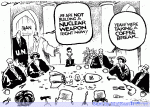Iran’s universities are again the scene of battles over the country’s future. In the digital age, we’re able to take a better peek inside.
Footage of recent student protests in Tehran, Shiraz and Hamedan are all over the Internet. In particular, one clip of a student dressing down a government dignitary reveals a remarkable willingness to defy the regime. On the video, a young man at Shiraz University rises to address the visiting speaker of parliament and former nuclear negotiator, Ali Larijani. “I’m not going to ask you a question because I don’t accept you as the legitimate speaker or the parliament as legitimate,” the student says, citing the elimination of opposition candidates in the previous parliamentary election.
Sitting on stage before a hundred or so students, Mr. Larijani looks taken aback and says nothing. “Let me tell you what is weighing heavily on my heart,” the student continues. “I hate three things. One, I hate [President] Mahmoud Ahmadinejad.”
Applause erupts — in itself an act of defiance, since the mullahs consider clapping, along with neckties, a Western habit. “Two, I hate him for his hypocrisy.” At this point, some pro-regime students — whom reports link to the government-sanctioned Basij organization, the mullahs’ brown shirts — interrupt with chants and heckles. Amid the mayhem, the video ends. We don’t know the young man’s name or what happened to him after this October 9 encounter. Some Iranians speculate he was arrested; others say he went into hiding.
Since the last student uprising was crushed six years ago, Iran has seen sporadic but growing resistance to the regime — most recently at the “Student Day” rallies on December 6 that commemorate the 1953 killing of three demonstrators by the Shah’s army. The Shiraz student calls to mind the lone man, that “unknown rebel,” who stood up to Chinese tanks during the Tiananmen protests. President-elect Obama says the U.S. should engage Iran. As one of our friends points out, “He has a choice: Engage with what Larijani represents, or engage with the generation of that student.”
View Source Here











